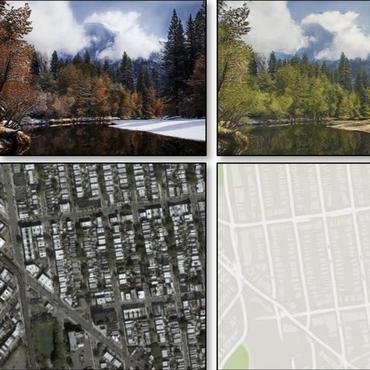Search Results for author: Anders Eklund
Found 20 papers, 9 papers with code
Gaussian process regression can turn non-uniform and undersampled diffusion MRI data into diffusion spectrum imaging
no code implementations • 9 Nov 2016 • Jens Sjölund, Anders Eklund, Evren Özarslan, Hans Knutsson
We propose to use Gaussian process regression to accurately estimate the diffusion MRI signal at arbitrary locations in q-space.
Generative Adversarial Networks for Image-to-Image Translation on Multi-Contrast MR Images - A Comparison of CycleGAN and UNIT
3 code implementations • 20 Jun 2018 • Per Welander, Simon Karlsson, Anders Eklund
Here, we evaluate two unsupervised GAN models (CycleGAN and UNIT) for image-to-image translation of T1- and T2-weighted MR images, by comparing generated synthetic MR images to ground truth images.
Generating Diffusion MRI scalar maps from T1 weighted images using generative adversarial networks
1 code implementation • 5 Oct 2018 • Xuan Gu, Hans Knutsson, Markus Nilsson, Anders Eklund
Diffusion magnetic resonance imaging (diffusion MRI) is a non-invasive microstructure assessment technique.
Refacing: reconstructing anonymized facial features using GANs
1 code implementation • 15 Oct 2018 • David Abramian, Anders Eklund
Anonymization of medical images is necessary for protecting the identity of the test subjects, and is therefore an essential step in data sharing.
Characterization of Brain Cortical Morphology Using Localized Topology-Encoding Graphs
no code implementations • 17 Oct 2018 • Sevil Maghsadhagh, Mousa Shamsi, Anders Eklund, Hamid Behjat
Spectral features of these graphs are then studied and proposed as descriptors of cortical morphology.
Graph Spectral Characterization of Brain Cortical Morphology
no code implementations • 19 Feb 2019 • Sevil Maghsadhagh, Anders Eklund, Hamid Behjat
The human brain cortical layer has a convoluted morphology that is unique to each individual.
Spatial 3D Matérn priors for fast whole-brain fMRI analysis
no code implementations • 25 Jun 2019 • Per Sidén, Finn Lindgren, David Bolin, Anders Eklund, Mattias Villani
Bayesian whole-brain functional magnetic resonance imaging (fMRI) analysis with three-dimensional spatial smoothing priors have been shown to produce state-of-the-art activity maps without pre-smoothing the data.
Methodology Applications Computation
Generating fMRI volumes from T1-weighted volumes using 3D CycleGAN
no code implementations • 19 Jul 2019 • David Abramian, Anders Eklund
Registration between an fMRI volume and a T1-weighted volume is challenging, since fMRI volumes contain geometric distortions.
Feeding the zombies: Synthesizing brain volumes using a 3D progressive growing GAN
1 code implementation • 11 Dec 2019 • Anders Eklund
Deep learning requires large datasets for training (convolutional) networks with millions of parameters.
Vox2Vox: 3D-GAN for Brain Tumour Segmentation
3 code implementations • 19 Mar 2020 • Marco Domenico Cirillo, David Abramian, Anders Eklund
Gliomas are the most common primary brain malignancies, with different degrees of aggressiveness, variable prognosis and various heterogeneous histological sub-regions, i. e., peritumoral edema, necrotic core, enhancing and non-enhancing tumour core.
Synthesizing brain tumor images and annotations by combining progressive growing GAN and SPADE
no code implementations • 13 Sep 2020 • Mehdi Foroozandeh, Anders Eklund
Training segmentation networks requires large annotated datasets, but manual annotation is time consuming and costly.
Does anatomical contextual information improve 3D U-Net based brain tumor segmentation?
no code implementations • 26 Oct 2020 • Iulian Emil Tampu, Neda Haj-Hosseini, Anders Eklund
The BraTS2020 dataset was used to train and test two standard 3D U-Net models that, in addition to the conventional MR image modalities, used the anatomical contextual information as extra channels in the form of binary masks (CIM) or probability maps (CIP).
What is the best data augmentation for 3D brain tumor segmentation?
2 code implementations • 26 Oct 2020 • Marco Domenico Cirillo, David Abramian, Anders Eklund
Training segmentation networks requires large annotated datasets, which in medical imaging can be hard to obtain.
Evaluation of augmentation methods in classifying autism spectrum disorders from fMRI data with 3D convolutional neural networks
no code implementations • 20 Oct 2021 • Johan Jönemo, David Abramian, Anders Eklund
Classifying subjects as healthy or diseased using neuroimaging data has gained a lot of attention during the last 10 years.
Inflation of test accuracy due to data leakage in deep learning-based classification of OCT images
1 code implementation • 21 Feb 2022 • Iulian Emil Tampu, Anders Eklund, Neda Haj-Hosseini
In the application of deep learning on optical coherence tomography (OCT) data, it is common to train classification networks using 2D images originating from volumetric data.
NUQ: A Noise Metric for Diffusion MRI via Uncertainty Discrepancy Quantification
no code implementations • 3 Mar 2022 • Shreyas Fadnavis, Jens Sjölund, Anders Eklund, Eleftherios Garyfallidis
However, it is hard to estimate the impact of noise on downstream tasks based only on such qualitative assessments.
Does an ensemble of GANs lead to better performance when training segmentation networks with synthetic images?
no code implementations • 8 Nov 2022 • Måns Larsson, Muhammad Usman Akbar, Anders Eklund
Large annotated datasets are required to train segmentation networks.
Efficient brain age prediction from 3D MRI volumes using 2D projections
1 code implementation • 10 Nov 2022 • Johan Jönemo, Muhammad Usman Akbar, Robin Kämpe, J Paul Hamilton, Anders Eklund
Using 3D CNNs on high resolution medical volumes is very computationally demanding, especially for large datasets like the UK Biobank which aims to scan 100, 000 subjects.
Beware of diffusion models for synthesizing medical images -- A comparison with GANs in terms of memorizing brain MRI and chest x-ray images
no code implementations • 12 May 2023 • Muhammad Usman Akbar, Wuhao Wang, Anders Eklund
Diffusion models were initially developed for text-to-image generation and are now being utilized to generate high-quality synthetic images.
Brain tumor segmentation using synthetic MR images -- A comparison of GANs and diffusion models
1 code implementation • 5 Jun 2023 • Muhammad Usman Akbar, Måns Larsson, Anders Eklund
Our results show that segmentation networks trained on synthetic images reach Dice scores that are 80% - 90% of Dice scores when training with real images, but that memorization of the training images can be a problem for diffusion models if the original dataset is too small.








